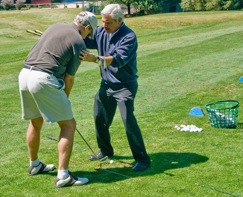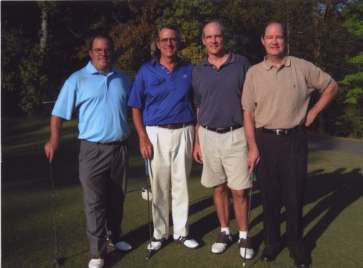A few weeks back, when I read the email from the Atlanta Press Club that John Huey, editor-in-chief of Time, Inc., was coming to speak today, I immediately signed up for three tickets. Not just because John oversees 140 different magazines and has one of the most interesting media jobs in the world, but because he grew up on East Wesley Road next door to Tom Murphy.
Tom is an old friend whose family I knew back in the old elementary school days at Christ the King. Many years later, when I started a neighborhood newspaper called Atlanta 30306 in the Virginia-Highland neighborhood (later renamed Atlanta Intown), Tom was one of the first people I visited to try to convince to advertise in the start-up. He did, for many years. In the process, we renewed our friendship and became best buddies.
A few years ago, I was having a beer with Tom when he was discussing the upcoming 25th anniversary of his restaurant. I suggested he publish a book, recounting his many entrepreneurial adventures, but he was reluctant, wanting instead to print a book of recipes. I kept pushing him. “This will brand you in ways you’ll never predict,” I said. “The very fact that you have a book about your restaurant will elevate your brand, but it will be a great book because you have so many great stories. Besides, I know the perfect writer.”

So thus began the long journey of Tom and my former editor and later bride, Jan Butsch Schroder, of compiling the book now known as Murphy’s, 25 Years of Recipes and Memories. The book published to great acclaim and a large, front-page story on the front of the AJC Living section. It is full of great recipes, photos and, most of all, stories … stories about being embezzled, robbed, about having to fire his wife after she threw a wet towel at him when a patron kissed Tom on the cheek, about the many great chefs who got their start at Murphy’s.
Tom, like Jan, is a private person, whose nature is not to step in the spotlight. And he hates public speaking. Once, when he had to introduce Hank Payne, president of Woodward Academy, Tom was too intimidated by the thought of standing in front of fellow classmates at Leadership Midtown and introducing the former college president. So when I suggested producing a video instead, Tom jumped at the chance.
As a child, Tom also had the distinction of growing up next door to John Huey in Garden Hills in Atlanta. As Tom tells the story, John grew up in a nice Southern Baptist household, but next door were the wild and crazy New York/Irish Catholic Murphys, with five children. Not only that, Tom’s parents also housed unwed mothers and, later, when Castro took over Cuba, dozens of Cuban refugee families. People were coming and going at all hours of the night at the Murphy household. John would look out his window and just shake his head at all the activity.

So when Jan began to assemble the book, getting quotes from celebrities who once ate there was one of her many tasks. Katie Couric, a frequent visitor to Murphy’s when she worked in Atlanta, was a non-starter. Her office said she was contractually obligated not to endorse restaurants. John Huey, after a number of emails, wrote back a wonderful quote that we included on page 10 of the book: “I grew up next door to the Murphy family. They were an exotic family, to say the least. Dad ran a cheese business out of the back yard and did a lot of ministering to the poor. Mom was a nurse and there were lots and lots of kids. Tom, or Tommy, as we knew him, was always my favorite because of that personality he still has today. My most vivid memory of him is as a young child, standing down by the curb of East Wesley Road, selling hot dogs from a little stand he had cobbled together. As you might expect, they were good. And they sold. So maybe Murphy’s is really a lot older than 25.”
One thing Jan tried to secure was a photo of John. But she couldn’t find one on the Internet and his assistant said, “There are no photos of John.” So we published the book without one, one of many loose ends we were never able to tie up before printing.
So, two years later, when I saw John was to speak to the press club, I bought tickets to the luncheon and VIP reception for me, Jan and Tom.
When the big day arrived, today, we drove down to the Commerce Club and took the elevator to the 18th floor reception. I brought along a copy of the book. We had sent one to John’s office, but we were always unsure if he ever received it. When he recognized “Tommy” and shook his hand and started telling old stories, we asked if he had ever seen his quote in the book. He said he didn’t. I said we weren’t able to get his photo to publish and John said in his dry humor, “No, there are no photos of me.” So we showed the book to him, gave him the autographed copy and walked away. I then saw Spark St. Jude, a photographer snapping away at the reception, so I went over and asked her to shoot a photo of the two boyhood neighbors, holding the book. She was able to take one or two, when an alarm went off.
The fire alarms went off in the Commerce Club, so we all had to walk down 18 flights of old dirty stairs to the street. A crowd of people stood on Broad Street downtown until the firemen came and inspected each floor. We were finally later able to get back to the 16th floor for the luncheon and the speech by John Huey, which was hilarious.
“Normally that fire drill trick works so I don’t have to give a speech,” John dead-panned. “In New York, if people walk down that many flights of stairs, they just go on back to work and the speech never happens. It didn’t work here.
“When the Atlanta Press Club invited me to speak, I said ‘no.’ (pause) I still feel that way,” he said to great laughter. He went on to tell many great stories of growing up in Atlanta, working for The Atlanta Constitution, and working with Alexis Scott, now publisher of the Atlanta Daily World. John claimed he had been duped into giving the speech after turning it down, when Alexis called to ask him to give a toast at the 10th anniversary of her being named publisher. Next thing he knew, he said, he was being promoted as giving the press club speech. So he proceeded to give Alexis her well-deserved toast, as well as talk about other aspects of journalism and Atlanta today.
At the end of his speech, John reached down and grabbed the Murphy’s book and told the crowd to buy it, as it contained “many great stories about Tom’s excellent restaurant in Virginia-Highland … and a quote from me on page 10.”
And there, many years later, I felt my prediction had been reinforced in spades, that Tom’s book would help brand him and his restaurant. For here Tom was being endorsed from the podium to a sell-out crowd at the Atlanta Press Club by the editor-in-chief of Time, Inc.
Now, if I can just get that photograph …
Photos: The book and the co-authors at earlier Atlanta Press Club Author’s Party, Jan and Tom











